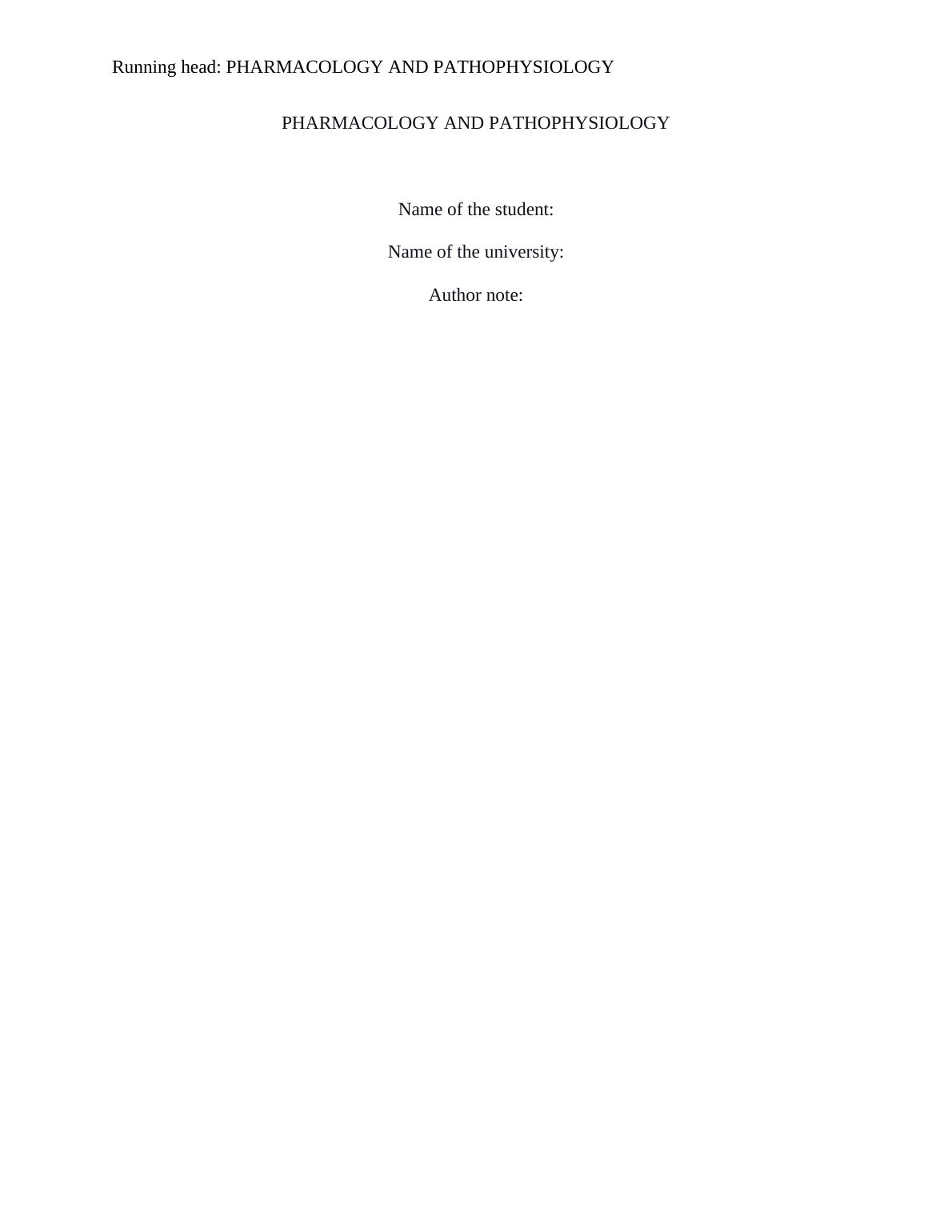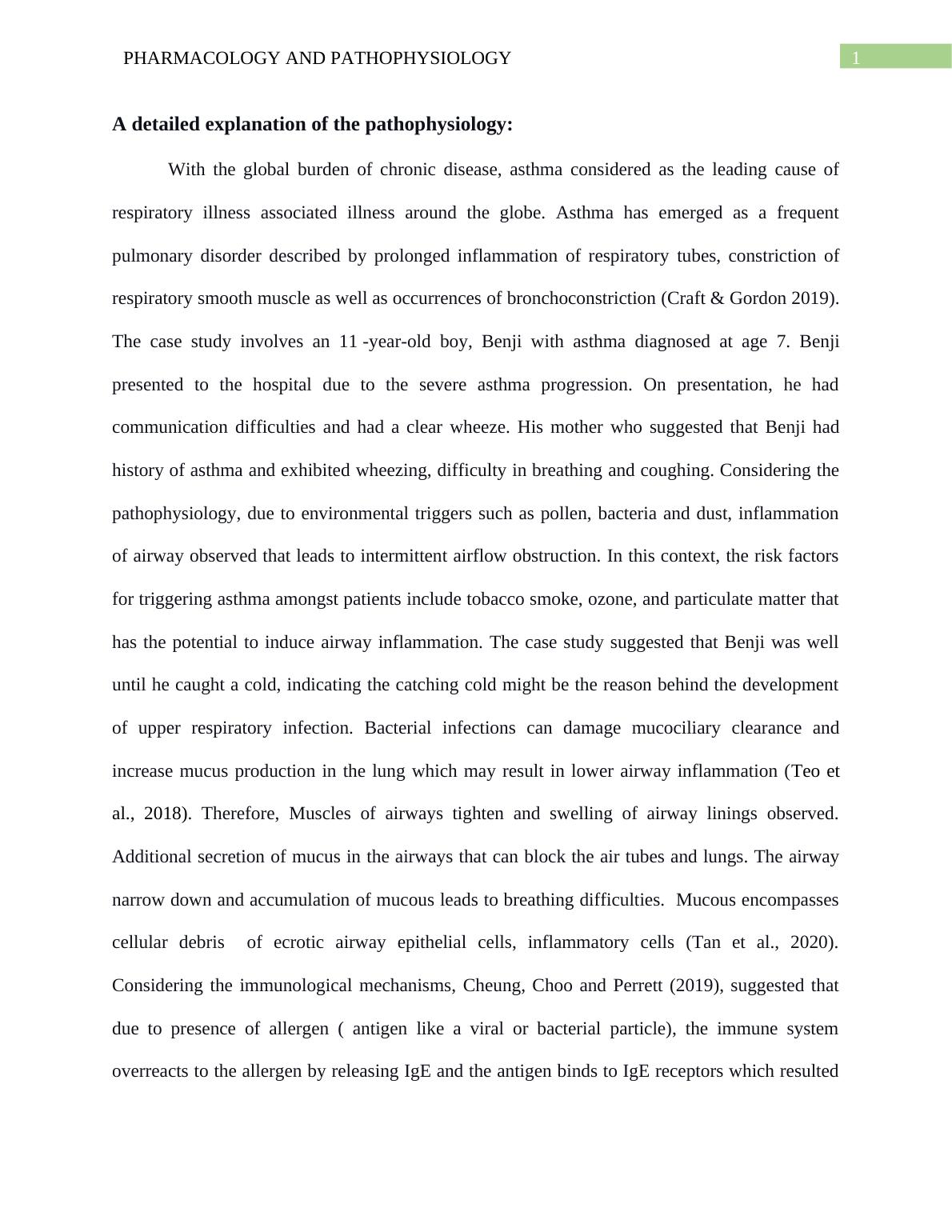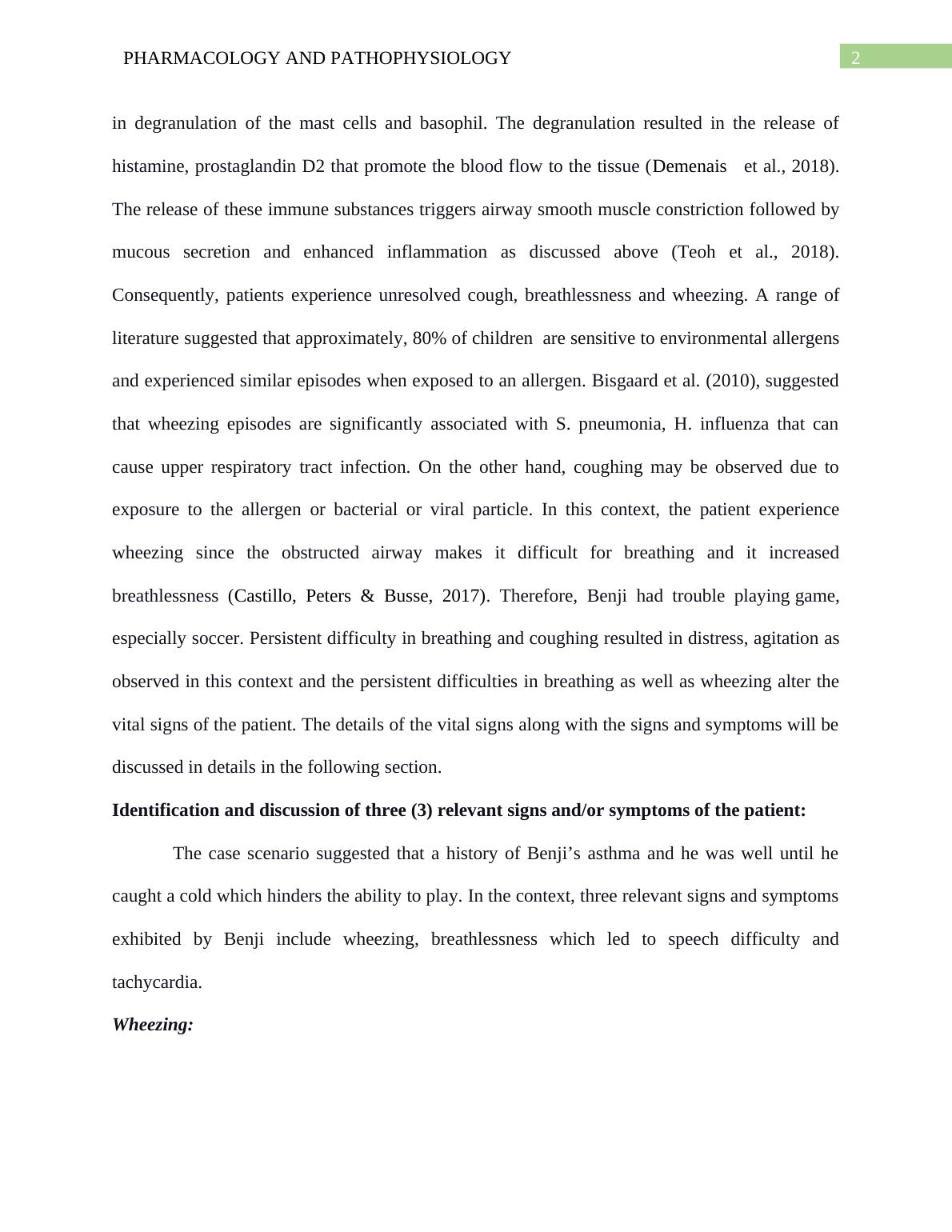Pharmacology and Pathophysiology
Added on 2022-08-27
12 Pages3125 Words20 Views
Running head: PHARMACOLOGY AND PATHOPHYSIOLOGY
PHARMACOLOGY AND PATHOPHYSIOLOGY
Name of the student:
Name of the university:
Author note:
PHARMACOLOGY AND PATHOPHYSIOLOGY
Name of the student:
Name of the university:
Author note:

PHARMACOLOGY AND PATHOPHYSIOLOGY1
A detailed explanation of the pathophysiology:
With the global burden of chronic disease, asthma considered as the leading cause of
respiratory illness associated illness around the globe. Asthma has emerged as a frequent
pulmonary disorder described by prolonged inflammation of respiratory tubes, constriction of
respiratory smooth muscle as well as occurrences of bronchoconstriction (Craft & Gordon 2019).
The case study involves an 11 -year-old boy, Benji with asthma diagnosed at age 7. Benji
presented to the hospital due to the severe asthma progression. On presentation, he had
communication difficulties and had a clear wheeze. His mother who suggested that Benji had
history of asthma and exhibited wheezing, difficulty in breathing and coughing. Considering the
pathophysiology, due to environmental triggers such as pollen, bacteria and dust, inflammation
of airway observed that leads to intermittent airflow obstruction. In this context, the risk factors
for triggering asthma amongst patients include tobacco smoke, ozone, and particulate matter that
has the potential to induce airway inflammation. The case study suggested that Benji was well
until he caught a cold, indicating the catching cold might be the reason behind the development
of upper respiratory infection. Bacterial infections can damage mucociliary clearance and
increase mucus production in the lung which may result in lower airway inflammation (Teo et
al., 2018). Therefore, Muscles of airways tighten and swelling of airway linings observed.
Additional secretion of mucus in the airways that can block the air tubes and lungs. The airway
narrow down and accumulation of mucous leads to breathing difficulties. Mucous encompasses
cellular debris of ecrotic airway epithelial cells, inflammatory cells (Tan et al., 2020).
Considering the immunological mechanisms, Cheung, Choo and Perrett (2019), suggested that
due to presence of allergen ( antigen like a viral or bacterial particle), the immune system
overreacts to the allergen by releasing IgE and the antigen binds to IgE receptors which resulted
A detailed explanation of the pathophysiology:
With the global burden of chronic disease, asthma considered as the leading cause of
respiratory illness associated illness around the globe. Asthma has emerged as a frequent
pulmonary disorder described by prolonged inflammation of respiratory tubes, constriction of
respiratory smooth muscle as well as occurrences of bronchoconstriction (Craft & Gordon 2019).
The case study involves an 11 -year-old boy, Benji with asthma diagnosed at age 7. Benji
presented to the hospital due to the severe asthma progression. On presentation, he had
communication difficulties and had a clear wheeze. His mother who suggested that Benji had
history of asthma and exhibited wheezing, difficulty in breathing and coughing. Considering the
pathophysiology, due to environmental triggers such as pollen, bacteria and dust, inflammation
of airway observed that leads to intermittent airflow obstruction. In this context, the risk factors
for triggering asthma amongst patients include tobacco smoke, ozone, and particulate matter that
has the potential to induce airway inflammation. The case study suggested that Benji was well
until he caught a cold, indicating the catching cold might be the reason behind the development
of upper respiratory infection. Bacterial infections can damage mucociliary clearance and
increase mucus production in the lung which may result in lower airway inflammation (Teo et
al., 2018). Therefore, Muscles of airways tighten and swelling of airway linings observed.
Additional secretion of mucus in the airways that can block the air tubes and lungs. The airway
narrow down and accumulation of mucous leads to breathing difficulties. Mucous encompasses
cellular debris of ecrotic airway epithelial cells, inflammatory cells (Tan et al., 2020).
Considering the immunological mechanisms, Cheung, Choo and Perrett (2019), suggested that
due to presence of allergen ( antigen like a viral or bacterial particle), the immune system
overreacts to the allergen by releasing IgE and the antigen binds to IgE receptors which resulted

PHARMACOLOGY AND PATHOPHYSIOLOGY2
in degranulation of the mast cells and basophil. The degranulation resulted in the release of
histamine, prostaglandin D2 that promote the blood flow to the tissue (Demenais et al., 2018).
The release of these immune substances triggers airway smooth muscle constriction followed by
mucous secretion and enhanced inflammation as discussed above (Teoh et al., 2018).
Consequently, patients experience unresolved cough, breathlessness and wheezing. A range of
literature suggested that approximately, 80% of children are sensitive to environmental allergens
and experienced similar episodes when exposed to an allergen. Bisgaard et al. (2010), suggested
that wheezing episodes are significantly associated with S. pneumonia, H. influenza that can
cause upper respiratory tract infection. On the other hand, coughing may be observed due to
exposure to the allergen or bacterial or viral particle. In this context, the patient experience
wheezing since the obstructed airway makes it difficult for breathing and it increased
breathlessness (Castillo, Peters & Busse, 2017). Therefore, Benji had trouble playing game,
especially soccer. Persistent difficulty in breathing and coughing resulted in distress, agitation as
observed in this context and the persistent difficulties in breathing as well as wheezing alter the
vital signs of the patient. The details of the vital signs along with the signs and symptoms will be
discussed in details in the following section.
Identification and discussion of three (3) relevant signs and/or symptoms of the patient:
The case scenario suggested that a history of Benji’s asthma and he was well until he
caught a cold which hinders the ability to play. In the context, three relevant signs and symptoms
exhibited by Benji include wheezing, breathlessness which led to speech difficulty and
tachycardia.
Wheezing:
in degranulation of the mast cells and basophil. The degranulation resulted in the release of
histamine, prostaglandin D2 that promote the blood flow to the tissue (Demenais et al., 2018).
The release of these immune substances triggers airway smooth muscle constriction followed by
mucous secretion and enhanced inflammation as discussed above (Teoh et al., 2018).
Consequently, patients experience unresolved cough, breathlessness and wheezing. A range of
literature suggested that approximately, 80% of children are sensitive to environmental allergens
and experienced similar episodes when exposed to an allergen. Bisgaard et al. (2010), suggested
that wheezing episodes are significantly associated with S. pneumonia, H. influenza that can
cause upper respiratory tract infection. On the other hand, coughing may be observed due to
exposure to the allergen or bacterial or viral particle. In this context, the patient experience
wheezing since the obstructed airway makes it difficult for breathing and it increased
breathlessness (Castillo, Peters & Busse, 2017). Therefore, Benji had trouble playing game,
especially soccer. Persistent difficulty in breathing and coughing resulted in distress, agitation as
observed in this context and the persistent difficulties in breathing as well as wheezing alter the
vital signs of the patient. The details of the vital signs along with the signs and symptoms will be
discussed in details in the following section.
Identification and discussion of three (3) relevant signs and/or symptoms of the patient:
The case scenario suggested that a history of Benji’s asthma and he was well until he
caught a cold which hinders the ability to play. In the context, three relevant signs and symptoms
exhibited by Benji include wheezing, breathlessness which led to speech difficulty and
tachycardia.
Wheezing:

PHARMACOLOGY AND PATHOPHYSIOLOGY3
Wheezing is considered as high pitched whistling sound that occurred during breathing.
As discussed above wheezing is associated with bacteria such as with S. pneumonia, H.
influenza that can cause upper respiratory tract infection. Wheezing also significantly associated
viral infection such as picornavirus, coronavirus and influenza virus. His mother suggested that
Benji is experiencing an upper respiratory tract infection, indicating the upper respiratory tract
leads to wheezing. In this context, the patient experience wheezing since the obstructed airway
and inflammation of the airway makes it difficult for breathing and increase respiratory rate
(Owens, Laing, Zhang & Le Souëf, 2017). The patient had 30 breathing per minutes where
normal breathing rate is within 12 to 24 breathing per minutes, indicating difficulty in breathing.
Breathlessness:
Similar to the wheezing, Becker and Abrams (2017), suggested that difficulty in
breathing due to the triggers from the environmental allergen or antigen that caused the airway
tightening followed by swelling and mucous secretion. The case study highlighted that Benji had
an unresolved cough after respiratory breathing, indicating that unresolved cough might be the
reason behind breathlessness. The breathlessness or dyspnoea together increased the respiratory
rate as discussed above. On the other hand, the oxygen saturation of the patient also low due to
breathlessness (94% oxygen saturation whereas the normal oxygen saturation in the optimum
environment is 98%). After admission, the oxygen saturation level dropped to 90%, indicating
exacerbation of asthma. Bjerregaard et al. (2017), suggested that low oxygen saturation observed
amongst patients due to inability of lungs inhale oxygen and transport it the cells and tissues
which resulted in severe lung damage followed by organ damages. Consequently, breathing
difficulties resulted in difficulties in speaking as observed in this case where Benxi could voice
Wheezing is considered as high pitched whistling sound that occurred during breathing.
As discussed above wheezing is associated with bacteria such as with S. pneumonia, H.
influenza that can cause upper respiratory tract infection. Wheezing also significantly associated
viral infection such as picornavirus, coronavirus and influenza virus. His mother suggested that
Benji is experiencing an upper respiratory tract infection, indicating the upper respiratory tract
leads to wheezing. In this context, the patient experience wheezing since the obstructed airway
and inflammation of the airway makes it difficult for breathing and increase respiratory rate
(Owens, Laing, Zhang & Le Souëf, 2017). The patient had 30 breathing per minutes where
normal breathing rate is within 12 to 24 breathing per minutes, indicating difficulty in breathing.
Breathlessness:
Similar to the wheezing, Becker and Abrams (2017), suggested that difficulty in
breathing due to the triggers from the environmental allergen or antigen that caused the airway
tightening followed by swelling and mucous secretion. The case study highlighted that Benji had
an unresolved cough after respiratory breathing, indicating that unresolved cough might be the
reason behind breathlessness. The breathlessness or dyspnoea together increased the respiratory
rate as discussed above. On the other hand, the oxygen saturation of the patient also low due to
breathlessness (94% oxygen saturation whereas the normal oxygen saturation in the optimum
environment is 98%). After admission, the oxygen saturation level dropped to 90%, indicating
exacerbation of asthma. Bjerregaard et al. (2017), suggested that low oxygen saturation observed
amongst patients due to inability of lungs inhale oxygen and transport it the cells and tissues
which resulted in severe lung damage followed by organ damages. Consequently, breathing
difficulties resulted in difficulties in speaking as observed in this case where Benxi could voice

End of preview
Want to access all the pages? Upload your documents or become a member.
Related Documents
ASSIGNMENT ON PATHOPHYSIOLOGY AND PHARMACOLOGY.lg...
|13
|3607
|16
PATHOPHYSIOLOGY AND PHARMACOLOGYlg...
|10
|2793
|19
RESPIRATORY SYSTEM CASE STUDY 2022lg...
|10
|2709
|12
Asthma Pathophysiology: Etiology, Pathogenesis, Clinical Manifestations, Diagnosis, Treatment, Preventionlg...
|6
|1451
|136
Asthma Exacerbations: Pathogenesis, Prevention, and Treatment | Case Study Analysislg...
|7
|2096
|11
Type of Asthma: Allergic Asthma in a Six-Year-Old Childlg...
|5
|1500
|186
